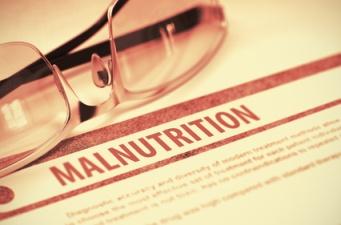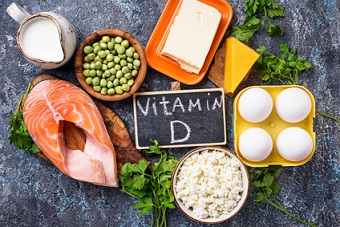Malnutrition and Pressure Injuries
January 4, 2018
Editor's note:This blog post is part of the WoundSource Trending Topics series, bringing you insight into the latest clinical issues and advancement in wound management, with contributions by the WoundSource Editorial Advisory Board.
Nutrition is a major determinant of health status. Food, as a vital source of nutrition, not only is essential to physiological well-being, but also impacts one's quality of life culturally, socially and psychologically.
Nutrition and Pressure Injury Healing
Current literature has identified more than 100 risk factors for pressure injury (PI) development. Some extrinsic (primary/non-physiological) and intrinsic (secondary/physiological) risk factors that contribute to PI development include diabetes mellitus, peripheral vascular disease, malignancy, prolonged pressure on an area of the body, being 70 years of age and older, smoking, urinary and fecal incontinence, a low body mass index (BMI), and malnutrition.
Pathophysiologic and intrinsic factors at the core of PI formation include nutrition. Maintaining adequate parameters of nutrition is considered a best practice in both the prevention and treatment of PIs. Individuals with PIs or who are at risk for developing PIs should strive to achieve or maintain adequate nutrition parameters. Meeting macronutrient and micronutrient requirements forms the foundation of good health. This translates to consuming wholesome, nutrient-dense foods!
Health Implications of Nutrition Deficits
Malnutrition can affect not just the obvious, such as energy level. It also contributes to decreased mood, increased hospital admissions, and risk for falls secondary to muscle wasting.
Individuals under our care such as hospitalized patients are often admitted with protein-calorie malnutrition. In 2013, there were a reported 1.95 million hospital stays involving malnutrition. These included 1.25 million malnutrition-related stays with a diagnosis of protein-calorie malnutrition. Twenty-two percent of hospital admissions were classified as malnourished as a result of weight loss or failure to thrive. Other forms of malnutrition include cachexia, underweight, postsurgical non-absorption, and nutritional neglect.
Cachexia is a condition characterized by severe loss of body weight, fat, and muscle and increased protein catabolism caused by underlying illness. This condition increases patients' morbidity and mortality. Compared with other forms of malnutrition, individuals with cachexia have the highest in hospital mortality rate. Signs and symptoms of cachexia include decreased BMI, diminished fatty tissue accumulation, weight loss, muscle atrophy, fatigue, weakness, and anorexia. Treatment for cachexia involves addressing the actual disease. Nutrition interventions do not reverse this condition. Lean body mass will be lost even if a patient consumes more calories than they need.
Common nutrition-related risks for developing pressure injuries include unintended weight loss, undernutrition, increased nutrient needs (usually associated with medical conditions), malnutrition, dehydration, low BMI, inadequate food and fluid intake, and inability to feed self, to name a few.
Role of Nutrients in Wound Prevention and Healing
Sufficient macronutrients (carbohydrates, protein, fats, and water) and micronutrients (vitamins and minerals) are vital for the body to support tissue integrity and prevent breakdown. Research supports that weight loss and difficulties with eating can increase the incidence of PIs. Other nutrition-related risk factors that can contribute to PI development include a change in appetite, compromised dental health, gastrointestinal and elimination disturbances, decreased self-feeding abilities, drug-nutrient interactions, and alcohol and substance abuse.
Restrictive diets can contribute to a decreased intake of nutrients. A diet too low in protein will lack the amino acids needed for protein synthesis. In wound healing, protein plays a major role in the production of enzymes, collagen and connective tissue manufacture, and cell multiplication. Protein depletion impairs wound healing by preventing a desirable wound bed from forming. Caloric needs must be met for protein to be spared for buildup and repair. Although the amount of protein needed by patients with PIs can be debatable, protein levels higher than the adult recommendation of 0.8 grams per kilogram of body weight per day are generally accepted and recommended. The National Pressure Ulcer Advisory Panel (NPUAP) recommends 1.2 to 1.5 g protein/kg of body weight per day and 30 to 35 kcal/kg of body weight per day for wound healing.
Low-fat diets can be deficient in essential fatty acids, which the skin needs to maintain the lipid barrier. Carbohydrates are essential for the cells to carry out basic functions of metabolism and prevent gluconeogenesis from protein stores.
Water comprises nearly 60% of the adult body weight. Body water is maintained in three compartments: intracellular, interstitial, and intravascular. Water plays a role in wound-site hydration and oxygen perfusion, is a solvent for nutrients and other small molecules to diffuse into and out of cells, and removes waste from cells. Dehydration is a risk factor for wound development. Patients with draining wounds need additional fluids to replace losses.
Vitamin A fuels cellular differentiation in fibroblasts and is involved in collagen development. A true vitamin A deficiency, although rare, can result in delayed wound healing and compromised immune function. Research supports vitamin A's role in reversing the adverse effects of corticosteroids in terms of wound healing.
Vitamin C is vital for collagen production. Collagen and fibroblasts form the basis of the structure of a healing wound bed. A deficiency in vitamin C has been associated with prolonged wound healing time, decreased wound strength, and decreased immune function. Mega-doses of vitamin C have not been linked to an increased wound-healing rate. Although not appropriate for all patients, vitamin and mineral supplementation is most beneficial for patients with poor vitamin C intake because they are likely to have limited nutrient stores and for patients with a diagnosed vitamin C deficiency.
Zinc is associated with collagen formation, protein metabolism, vitamin A transport, and immune function. Zinc deficiency can emerge as a result of severe wound drainage or gastrointestinal losses, corticosteroid use, or a long-term decreased dietary intake. A chronic and/or severe zinc deficit can contribute to abnormal function of white blood cells including lymphocytes, added vulnerability to infection, and delayed wound healing. When considering supplementation, it is important to remember that consumption of increased zinc can interfere with copper metabolism, thus producing copper-induced anemia. The amount of zinc in a multivitamin and mineral supplement is generally adequate. Supplementing to no more than the upper tolerable limit of the dietary reference intake (40 mg of elemental zinc) until the deficiency is corrected can be recommended.
Aside from the role of vitamins and minerals, the role of individual amino acids in wound healing has been explored. Arginine is a conditionally essential amino acid that in several studies has been shown to raise concentrations of hydroxyproline, an indicator of collagen accumulation and protein in the wound site. Arginine stimulates growth factors and boosts the immune system. The NPUAP 2014 guideline suggests supplementing with high protein, arginine, and micronutrients for adults with a pressure injury stage 3 or 4 or multiple PIs when nutritional requirements cannot be met with traditional high-calorie and protein supplements.
Implications for Practice in Prevention and Treatment of Pressure Injuries
PI prevention and treatment have been important elements of clinical and nutritional care. Promoting optimum nutritional status is an essential component in the plan of care for individuals with PIs. Care goals should be patient centered and dynamic. A patient's response (or lack of response) to the interventions in the plan of care needs to be monitored. With changes in condition, the plan of care and the planned interventions must be revised to meet the new clinical demands of the patient.
The nutritional needs of the patient must be defined. As appropriate, patients or residents with PIs should receive 30 to 35 calories/kg body weight per day, adequate protein/kg body weight (as appropriate for their medical condition), fluids to promote adequate hydration, enhanced foods and/or medical supplements as needed, and a multivitamin when vitamin and mineral deficiency is diagnosed or suspected.
Sources
- Academy of Nutrition and Dietetics. Nutrition Care Manual. Available at: https://www.nutritioncaremanual.org/. Accessed December 28, 2017.
- American Dietetic Association. ADA Nutrition Care Manual. Available at: http://www.nutritioncaremanual.org/. Accessed December 28, 2017.
- Baranoski S, Ayello EA, eds. Wound Care Essentials: Practice Principles Third ed. Ambler, PA: Wolters Kluwer/Lippincott Williams & Wilkins; 2012.
- Bernstein M, Munoz N. Position of the Academy of Nutrition and Dietetics: food and nutrition for older adults: promoting health and wellness. J Acad Nutr Diet. 2012;112(8):1255-77.
- Centers for Medicare and Medicaid Services. State Operations Manual Appendix PP - Guidance to Surveyors for Long Term Care Facilities. Baltimore, MD: Centers for Medicare and Medicaid Services. Available at: http://www.cms.gov/Regulations-and-Guidance/Guidance/Manuals/downloads/…. Accessed December 28, 2017.
- Evans WJ. Skeletal muscle loss: cachexia, sarcopenia, and inactivity. Clin Nutr. 2010;91(4):1123S–7S. Available at: http://ajcn.nutrition.org/content/91/4/1123S.full. Accessed December 28, 2017.
- Horn SD, Bender SA, Ferguson ML, et al. The National Pressure Ulcer Long Term Care Study: pressure ulcer development in long-term care residents. J Am Geriatr Soc. 2004;52:359-67.
- Lyder C, Preston, Ahean D, al. e. Medicare Quality Indicator System: Pressure Ulcer Prediction and Prevention Module: Final Report. Bethesda, MD: Qualidigm/U.S. Healthcare Financing Administration;1998.
- MacKay D, Miller A. Nutritional support for wound healing. Alt Med Rev. 2003;8:359-77.
- Muscaritoli M, Anker SD, Argiles J, et al. Consensus definition of sarcopenia, cachexia, and pre-cachexia: Joint document elaborated by Special Interest Groups (SIG) "cachexia-anorexia in chronic wasting diseases" and "nutrition in geriatrics". Clin Nutr. 2010 Apr;29(2):154-9. doi: 10.1016/j.clnu.2009.12.004. Epub 2010 Jan 8.
- National Pressure Ulcer Advisory Panel, European Pressure Ulcer Advisory Panel, Pan Pacific Pressure Injury Alliance, eds. Prevention and Treatment of Pressure Ulcers: Clinical Practice Guidelines. Perth, Australia: Cambridge Media; 2014. Haesler EE, ed.
- Posthauer ME, Banks M, Dorner B, Schols JM. The role of nutrition for pressure ulcer management: National Pressure Ulcer Advisory Panel, European Pressure Ulcer Advisory Panel, and Pan Pacific Pressure Injury Alliance White Paper. Adv Skin Wound Care. 2015;28(4):175-88.
- Stechmiller JK, Cowan L, Whitney JD, et al. Guidelines for the prevention of pressure ulcers. Wound Repair Regen. 2008;16:151-68.
- Weiss JA, Fingar KR, Barrett ML, et al. Statistical Brief #210: Characteristics of Hospital Stays Involving Malnutrition, 2013. Healthcare Cost and Utilization Project (HCUP). Available at: https://www.hcup-us.ahrq.gov/reports/statbriefs/sb210-Malnutrition-Hosp… Published September 2016. Accessed December 28, 2107.
About the Author
Dr. Nancy Munoz is the Assistant Chief for Nutrition and Food Service for the Southern Nevada VA Healthcare System. Teaching healthcare practitioners the role of nutrition as a modifiable risk in the development of pressure ulcers is at the core of her practice. Dr. Munoz has authored and served as expert reviewer for books and manuscripts for numerous professional publications, and the Academy of Nutrition Evidence Analysis Library. She currently serves as the Professional Development Chair for the Dietetics in Healthcare Communities DPG, is a member of the Academy’s Positions Committe and the WoundSource editorial advisory board, and is the current Vice President for the National Pressure Ulcer Advisory Panel.
The views and opinions expressed in this content are solely those of the contributor, and do not represent the views of WoundSource, HMP Global, its affiliates, or subsidiary companies.










